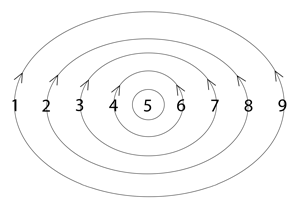center
1-1-2
Conventional Understanding
Traditionally, we think of “center” as a physical location—the middle point where we need to go. We talk about “finding our center” as if it’s a destination, somewhere we need to reach or maintain. This limited view reinforces the illusion that we’re separate from the organizing principle of life, constantly seeking to locate or reconnect with a center that exists independently of our awareness.
Resonant Understanding
Word Cosmology reveals “center” carrying a 1-1-2 resonance pattern, sharing this signature with “electrical resonance,” “ether,” and “pressure gradients.” This suggests center isn’t somewhere to go but something already happening—the organizing principle through which everything naturally aligns.
Think of a spinning top. Its stability doesn’t come from reaching its center but from organizing around it. Similarly, center is the invisible organizing principle that allows experience to unfold simultaneously rather than sequentially.
Expressions Spectrum Analysis
In balanced expression, this resonance pattern appears as “the action occurs simultaneously,” “information knowing,” and “perfect union.” When aligned with center, we experience “self-organization” and “conveying feelings”—things flow naturally without forcing.
When over-modulated, expressions include “one way,” “defined,” and “fabricated motion.” Center becomes rigid when treated as a fixed location rather than an organizing principle. “Mental reality” and “justify” show how we construct artificial explanations instead of allowing natural organization.
Under-modulated expressions such as “disharmony with life,” “waiting,” and “I am fearful” show what happens when we feel disconnected from this organizing principle. Experience lacks coherence when we don’t align with center’s natural function.
Beyond these patterns, expressions like “thought wave universe,” “still point of the one light,” and “cube wave fields” suggest deeper aspects of how center functions in the creative sequence.
Russell’s Cosmogony Connection
Walter Russell described this organizing principle as “the fulcrum of the universe from which actions and reactions extend and return.” Like a mirror that doesn’t create images but organizes light into patterns, center doesn’t create experience but provides the field through which it unfolds coherently.
Russell further illuminated this with his description of the still magnetic Light as “the zero fulcrum of the wave lever from which motion is projected.” Center functions as this eternal organizing principle—not a destination to reach but the foundational field from which all patterns extend and to which they return.
Practical Implications
This understanding transforms how we approach balance in life. Rather than trying to “find our center” as if it were a location, we might recognize it as the organizing principle already at work.
Instead of seeking to reach a centered state, we can allow natural organization to emerge by aligning with what’s already happening. This shifts our practice from directed effort to aligned participation—not trying to get somewhere but recognizing we’re already expressions of the organizing principle that enables coherent experience.
Walter Russell’s quotes are from his book, “A New Concept of the Universe”
Related Words:
No results found.


